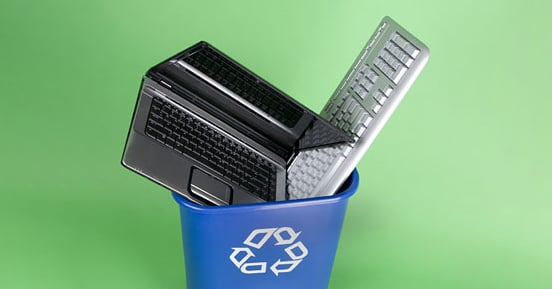Elevate the power of your work
Get a FREE consultation today!
If you struggle with how to manage your retired tech assets, you're not alone. In fact, e-waste is one of the IT industry's biggest challenges.

From Fortune 500 companies to small startups, electronics play a key role in facilitating everyday business operations. Trying to operate without laptops, cell phones, or other smart devices is nearly impossible. When these assets inevitably break or become out-of-date, the search for replacements begins.
But what happens after these devices have served their useful purpose? It turns out they mostly get deposited into e-waste streams. If you struggle with how to manage your retired tech assets, you're not alone. In fact, e-waste is one of the IT industry's biggest challenges.
It sounds like a buzzword, but e-waste is a key concentration area for IT asset lifecycle management (ALM). Electronics turn into e-waste when they are unwanted, no longer working, or at the end of their useful life.
Out of sight, out of mind? While some may not give their IT assets much thought after they’re gone, devices that are tossed out with the trash have turned into a significant environmental problem. By 2030, e-waste is predicted to reach 74 million metric tonnes per year, a 16.6 million metric ton jump from 2021.
So what happens to all of these devices if not properly disposed of?
To avoid contributing to irresponsible e-waste practices, we recommend the following sustainable secure IT asset disposition (ITAD) best practices:
After your team has made a decision on what to do with retired or obsolete IT assets, there's still some work to do.
Sensitive company information may still be stored on your devices. So, before you recycle, remarket, or redeploy anything, be sure to securely erase any information that could put your company at risk for a data breach.
Devices must be meticulously scanned and data thoroughly expunged before it leaves the premises for repurposing or redeploying. But it's not as straightforward as you think. Deleting files removes them from directories but actually touches very little data. Similarly, formatting a disk drive deletes pointers to files, but most of the contents of data-bearing devices can be recovered with special software. Even multiple formatting passes are no guarantee.
Many third-party vendors are willing to remarket or recycle retired IT assets, but your organization should exercise caution when selecting a partner. In many cases, the transition to a vendor is the first time equipment will leave your company's control. Data erasure is the most important part of the asset disposition process and the easiest place for a vendor to cut corners. If you feel hesitant, there's always the option to have the vendor do an onsite data sanitization service. It's also good to keep an eye out for those with a proven chain-of-custody and destruction with verified third-party certifications such as R2, e-Stewards, and NAID.
Not only can you initiate proactive security measures, you can embed sustainable practices into how your organization operates.
Here's how to ensure your company disposes of its end-of-life IT assets in a sustainable and environmentally compliant manner:
There are no one-size-fits-all e-waste regulations. Depending on your industry and where you do business, there are variations on what you need to do once your IT assets are no longer useful to your company.
In the United States, there are different regulations at both the state and federal level. Currently, 25 states have laws for electronic recycling and Europe's Waste from Electrical and Electronic Equipment (WEEE) directive has been in effect since 2003. It sets the rules companies are required to follow when discarding their electronic devices.
The Global E-Waste Statistics Partnership is a great resource for staying up-to-date on e-waste legislation. Be sure your ITAD partner is well versed and fully complies with all these regulations. While third-party certifications, such as R2 and e-Stewards, help ensure compliance, your team should also do its own due diligence.
Investing in responsible Secure ITAD practices is not only good for your company but also the environment.
Many organizations are required to report their numbers around e-waste generation and how their disposition practices impact the environment. With these changes—however big or small—to how they remarket, repurpose, or recycle their end-of-life electronic devices organizations can meet or exceed their environment, societal, and governance (ESG) goals while reducing their impact.
By reporting on critical data regarding waste generation, landfill diversion, and remarketing and recycling rates, organizations can proactively and transparently share their contribution to a more circular economy and sustainable future.
Remarketing and recycling electronics can:
Get a FREE consultation today!
